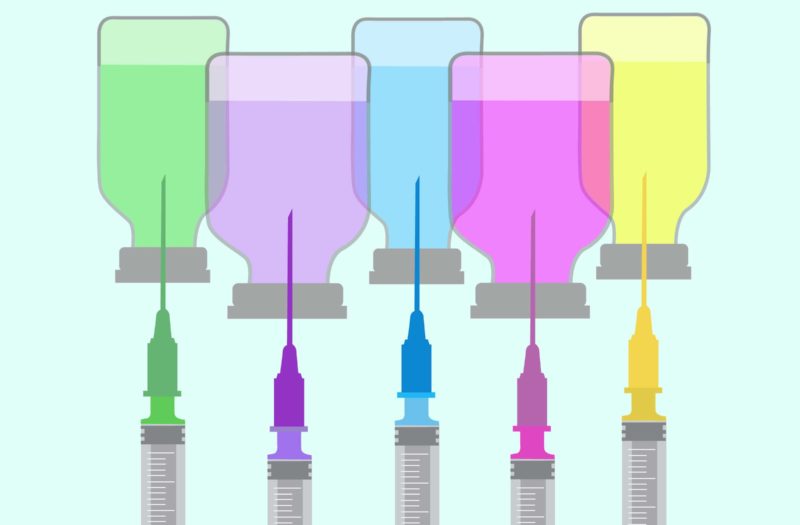Learn more about our FREE COVID-19 Patient Support Program for chronic illness patients and their loved ones.
Americans are still waiting for an FDA-approved vaccine for COVID-19, but there are already several questions about how a vaccine would be distributed and who would be given top priority for receiving a vaccination.
The National Academies of Sciences, Engineering, and Medicine recently released a draft of recommendations for COVID-19 vaccine allocation, which consists of a four-phrase approach. It is by no means the final framework for vaccine distribution, and is subject to change based on public comments and further deliberation from the vaccine allocation committee.
Still, the recommendations reveal some clues about what you might expect in terms of receiving a COVID-19 vaccine, particularly if you’re living with an underlying health condition that can put you at higher risk for COVID-19 complications.
Phase 1
This would be the “jumpstart phase” of the vaccine roll-out and would cover about 15 percent of the U.S. population in total. It would be divided into two parts:
Phase 1a
- High-risk workers in health care facilities
- First responders
Phase 1b
- People of all ages with comorbid and underlying conditions that put them at significantly higher risk
- Older adults living in congregate or overcrowded settings
Although experts don’t know for sure which underlying conditions put individuals at a significantly higher risk of severe COVID-19 or death, the U.S. Centers for Disease Control continues to gather information on this topic, per the paper. It lists the following as factors associated with an increased risk of severe COVID-19:
- Cancer
- Chronic kidney disease
- Chronic obstructive pulmonary disease (COPD)
- Immunocompromised state from solid organ transplant
- Obesity (body mass index [BMI] ≥ 30)
- Serious heart conditions (e.g. heart failure, coronary artery disease, cardiomyopathies)
- Sickle cell diabetes
- Type 2 diabetes
However, it would be unmanageable to vaccinate all individuals with any of the above conditions in Phase 1b, since hundreds of millions of people in the United States would be involved. As such, the initial group of recipients may need to be limited to those with two or more of these designated conditions.
“It should be noted that as the relationship between severe COVID-19 disease and certain comorbid conditions becomes clearer, this list is subject to evolve,” write the authors.
They go on to add that about 75 percent of adults hospitalized for COVID-19 in the United States from March 1 to August 15 had at least two comorbid conditions, and more than 60 percent had at least three underlying conditions, per Coronavirus Disease 2019 (COVID-19) Associated Hospitalization Surveillance Network (COVID-NET) data.
Phase 2
This phase would cover an estimated 30 to 35 percent of the American population. Phase 1 and Phase 2 combined would cover approximately 45 to 50 percent of the population.
- Critical risk workers (those who are both in industries essential to the functioning of society and at substantially high risk of exposure)
- Teachers and school staff
- People of all ages with comorbid and underlying conditions that put them at moderately higher risk
- All older adults not included in Phase 1
- People in homeless shelters or group homes for individuals with physical or mental disabilities or in recovery
- People in prisons, jails, detention centers, and similar facilities, and staff who work in such settings
In this phase, individuals with any one of the previously mentioned conditions in Phase 1b would be able to get a vaccine. The authors note that other comorbid conditions might be considered for this phase as more research is done.
For instance, the CDC has a list of comorbid conditions that might put individuals at increased risk and that could potentially be considered for this phase:
- Asthma (moderate to severe)
- Cerebrovascular disease
- Cystic fibrosis
- Hypertension
- Immunocompromised state from blood or bone marrow transplant
- Immune deficiencies
- HIV/AIDS
- Use of corticosteroids or use of other immunosuppressive medicines
- Neurologic conditions
- Liver disease
- Pregnancy
- Pulmonary fibrosis
- Smoking
- Thalassemia
- Type 1 diabetes
Approximately 12 percent of adults hospitalized for COVID-19 in the United States between March 1 and August 15 of this year had one select comorbid or underlying condition, per the COVID-NET data.
At this time, the authors note that they cannot accurately estimate the number of individuals in this population group since they can’t account for those with multiple comorbid conditions in Phase 1b, but it would likely include tens of millions of people.
Meanwhile, the older adult population included in this group is estimated to include over 49.2 million older adults, if “older adults” is considered people age 65 and older. (However, the authors write that they defer to the Advisory Committee on Immunization Practices to determine specific age guidelines as more health and vaccine data become available.)
“The case fatality proportion for COVID-19 is substantially higher among older adults in the United States, and the rate of hospitalization for COVID-19 increases with age,” note the authors. “Ultimately, one could argue that age is itself an underlying condition for COVID-19 given the high risk of severe disease and death due to COVID-19 among older adults.”
Phase 3
This phase would cover approximately 40 to 45 percent of the American population. Phases 1 to 3 together would cover 85 to 95 percent of the population.
- Young adults (ages 18 to 30)
- Children
- Workers in industries essential to the functioning of society and at increased risk of exposure not included in Phase 1 or 2
Phase 4
This phase would cover everyone residing in the United States who did not receive the vaccine in previous phases. The authors note that all Americans who did not receive the vaccine in previous phases (and for whom the vaccine is not medically discouraged, although there are no known reasons as to why this would be yet) should do so within the first 12 to 18 months of the vaccine roll-out.
The committee does not call out people of color — specifically Black, Hispanic or Latinx, and American Indian and Alaska Native people — who have been disproportionately impacted by COVID-19.
The authors note that this is because they believe the increased risk comes from higher rates of comorbidities and socioeconomic factors, which the phases attempt to address.
“Currently there is little evidence that this is biologically mediated, but rather reflects the impact of systemic racism leading to higher rates of comorbidities that increase the severity of COVID-19 infection and the socioeconomic factors that increase likelihood of acquiring the infection, such as having front line jobs, crowded living conditions, lack of access to personal protective equipment, and inability to work from home,” write the authors. “Therefore, the committee’s draft framework focuses on these underlying causes instead of discrete racial and ethnic categories.”
However, not everyone agrees with these suggested recommendations.
Advocacy groups have expressed that the phases should expand to specifically prioritize racial or ethnic groups most severely impacted by COVID-19 (since the current top-priority phases may not capture particular racial or ethnic minorities), as well as specific occupations like pharmacists, dentists, and farmworkers.
Get Free Coronavirus Support for Chronic Illness Patients
Join the Global Healthy Living Foundation’s free COVID-19 Support Program for chronic illness patients and their families. We will be providing updated information, community support, and other resources tailored specifically to your health and safety. Join now.
Discussion Draft of the Preliminary Framework for Equitable Allocation of COVID-19 Vaccine. The National Academies of Sciences, Engineering and Medicine. September 1, 2020. doi: https://doi.org/10.17226/25914.
Public Listening Session: Discussion Draft of the Preliminary Framework for Equitable Allocation of COVID-19 Vaccine. The National Academies of Sciences, Engineering and Medicine. September 2, 2020. https://www.nationalacademies.org/event/09-02-2020/public-listening-session-discussion-draft-of-the-preliminary-framework-for-equitable-allocation-of-covid-19-vaccine.






